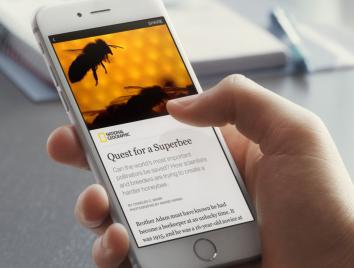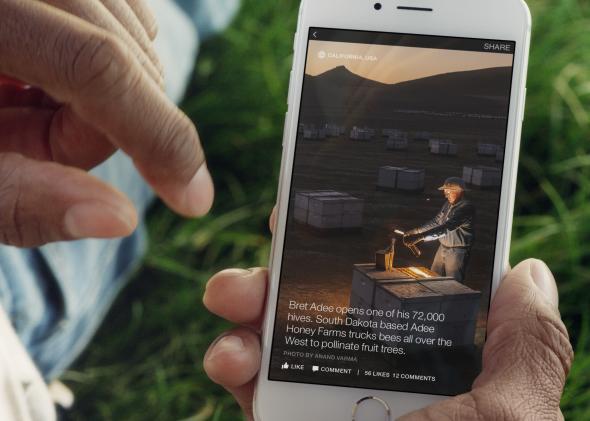Wednesday, May 13, 2015: That’s the day journalism sold its soul, according to some of the more hysterical corners of the media echo chamber.
What actually happened is that Facebook launched a feature called Instant Articles. The feature allows Facebook users to read full interactive stories from the New York Times, BuzzFeed, National Geographic, and others without leaving Facebook. In the past, media outlets simply posted links on Facebook that directed readers to their own websites to read the full story. Now they’re allowing Facebook to host those same stories, which gives Facebook unprecedented control over their content.
You can see the inaugural batch of Instant Articles today by logging into the Facebook mobile app on an iOS device. (An Android version is reportedly in the works.) If your friends happen to be sharing them, they’ll appear in your News Feed just like any other Facebook post would. Otherwise you can seek them out at https://www.facebook.com/instantArticles, although you’ll have to do it in the latest version of the mobile iOS app if you want to see what they look like. On your Web browser, they’ll just look like normal articles.
Normally, when you click on a link in the Facebook app, it takes several seconds to open your mobile device’s browser, connect with the host publisher, and load all the elements of their website. Even then the story might not look very good on your phone, since many websites are still designed with desktop computers in mind. Videos and interactive elements might not work properly, if they load at all.
That’s a relatively minor annoyance for readers. It’s a slightly bigger problem for media websites, which risk missing out on traffic and revenue when frustrated readers skip over their links in favor of other Facebook posts that don’t require leaving the app. And it’s potentially a very serious problem for Facebook, whose multi-hundred-billion-dollar business model centers on keeping its users happy, engaged, and spending as much time in their News Feeds as possible. Facebook knows that personal status updates and baby photos can only take it so far, and it’s betting big on becoming people’s primary news source as a way to broaden its value to users.
Instant Articles solve the problem by making Facebook the destination for news stories, rather than the middleman. You’ll quickly notice the difference: The articles posted directly on Facebook come with moving pictures, pretty fonts, interactive elements, and an assortment of other bells and whistles that you’ll rarely encounter on the mobile Web. In short, they look great—and they load almost instantly.
All of which sounds like good news for Facebook and its users. But is it good news for online media, whose business model has typically relied on drawing readers into their own websites? The broad consensus on Wednesday was: No, it’s terrible for online media, which are now ceding control of their journalistic content to a predatory tech company bent on global domination.
I was among the earliest doomsayers. In January, when Facebook began urging publishers and other “creators” to upload videos directly so that they’d autoplay in users’ feeds, I predicted that it would soon do the same with full news articles. I headlined my article, “Facebook is Eating the Media,” a nod to the venture capitalist Marc Andreessen’s claim that software is eating the world. In March, when the New York Times confirmed that Facebook was in talks with publishers to do just that, I worried that the terms would be hopelessly skewed in Facebook’s favor—and that media outlets, unable to bargain with Facebook collectively, would be compelled to accept them anyway.
Now I find myself in an odd position. On the same day that the rest of the media are finally freaking out the way I was a few months ago, I’m feeling oddly reassured. That’s because the initial terms of the partnership are more favorable to publishers than I could have imagined.
First of all, the articles don’t look or feel like Facebook posts: From the fonts to the artwork to the little formatting flourishes, each Instant Article bears the unmistakable visual imprint of the news organization that created it.
More importantly, the publishers don’t have to shoehorn their work into some newfangled format created by Facebook, as they do with Snapchat’s Discover feature. They just publish their stories as usual, and Facebook’s code automatically converts them into Instant Article form. Facebook will allow publishers to track and measure the readership of the stories they post on the social network, and comScore will credit the publishers for that traffic.

Image courtesy of Facebook
Most surprisingly, Facebook will allow publishers to display their own ads inside their Instant Articles, with all the revenues from those ads going back to the publishers. Any unsold ad slots in a story will be filled by Facebook, with Facebook keeping a 30 percent cut of those revenues. That’s a remarkably generous arrangement.
That said, it also carries the whiff of a Godfather-style offer that you can’t refuse. Ostensibly, it’s all optional: Media outlets won’t be required to participate, and those that do can choose which articles they allow Facebook to ingest. The Times and other initial partners are adamant that this as an experiment, not a commitment. But, as I’ve explained, the optional can quickly become the inevitable when it comes to Facebook’s algorithms. Instant Articles are almost certain to perform better in the News Feed than conventional Web links, and those publishers that don’t participate will likely see their referral traffic wither.
In that respect, Facebook has online media by the tail. The thing is, it already had the industry by the tail, given how heavily publishers have come to depend on Facebook to funnel readers their way. This just happens to be the first time Facebook has really pulled on that tail. And the good news is that it’s a pretty gentle tug.
Don’t get me wrong: The media should still be wary. The terms of the deal look great now, but there’s little to stop Facebook from changing them once the Instant Articles format has caught on and everyone has bought in. That’s a point that the Verge’s great Casey Newton pressed Facebook on in his article about the deal:
I asked Justin Osofsky, Facebook’s vice president of media partnerships, whether [the revenue-sharing arrangement] was a limited-time offer that would change over time. “We’re committed to working with publishers in a way that gives them tools to build their business,” he said. So eventually you’ll take, what, 20, 30 percent? I asked. “We’re going to work with publishers to give them tools that build their business,” he repeated, unblinking.
(Note to self: If you ever want to paint a source as supremely creepy, be sure to describe their canned response to a tough question as “unblinking.”)
Moreover, as Re/Code’s Peter Kafka notes, the data that Facebook is sharing with publishers is not the really valuable stuff. Facebook retains full control over the data about its users’ identities and online behavior, which allows it to sell far more personalized ads than its media partners can offer. But no one seriously expected Facebook to share that with anyone, let alone National Geographic.
No doubt Facebook will ratchet up its share of the revenue down the line if it feels like it needs to. But the fact that it is in such a generous mood today is a good sign. It means that Facebook remains more concerned with keeping its users engaged in the News Feed than with shaking down publishers for a share of their (far less appetizing) display-advertising pie.
If journalists could pry their gaze from their own abdomens for a moment, they’d realize this makes sense. The Guardian and the New York Times are a big deal in the online-media world, but they’re pipsqueaks compared to Facebook and its heavyweight rivals in the tech sector, who are slugging it out for a much bigger prize. Why should Facebook waste its time bullying poor publishers when it could enlist them as allies in its long-term war for eyeballs and data with the likes of Google, Twitter, and Snapchat?
Only if Facebook grows desperate will it risk alienating its media partners by jerking them around with a lopsided deal. And if that happens, it will probably be because upstart social networks are chipping away at Facebook’s dominance—in which case, Facebook traffic will no longer be as crucial to publishers as it is today, and they’ll be free to strike a better deal with Snapchat or Tumblr or whatever else takes its place.
For better or worse, we may never see a return to the days when publishers fully controlled their ad sales and distribution. But the Facebook deal suggests they can at least hope to retain control over their content. And the fact that a Facebook rival such as Snapchat is also courting the media implies that publishers will retain enough leverage in such negotiations to sustain their businesses. In the long run, some might find they’re better off outsourcing their distribution and ad sales to well-funded tech giants and refocusing on what they do best: reporting the news.
When you look at it that way, the media aren’t really selling their souls to Facebook. They’re just renting them out until a better deal comes along.
